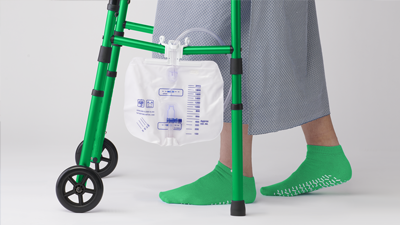Alternatives to catheters in your ED: How to go Foley-free
You can help prevent CAUTI while treating your incontinent patient.

Why are Foley catheters placed in emergency department (ED) patients? For medical reasons, patient and staff convenience, and out of habit.1
It’s a habit that should be broken. Consider these numbers:
- As many as 25% of inpatients have indwelling urinary catheters (IUCs) placed at some point during their hospitalization, many of which are placed in the ED setting2
- An estimated 3 million urinary catheters are placed during an ED encounter in the United States each year2
- Up to 65% of catheters placed in the ED may not be appropriate2
The good news: Implementation of a “Foley-free ED” is associated with reduced catheter-associated urinary tract infection (CAUTI) rates attributed to IUCs inserted in the ED.3
Following are 7 steps for implementing and evaluating a Foley-free ED.
Step 1
Gain leadership support
A 2017 multihospital study identified the need to establish interventional guidelines for the use of IUCs in the ED to promote reduction in unnecessary placement. The study also identified the importance of using clinical champions to promote adherence.2
“Embracing clinical champions is key to moving the needle toward a Foley-free ED,” says Mary Pat Eble, MSN, RN, Medline National Clinical product Specialist, Urology. “Physician and nurse champions are a must for using a holistic approach.”
To that end, identify both nurse and physician leaders to be the point people for the program in the ED. A potential good choice for a nurse leader is the ED nursing director, or a nurse manager/charge nurse. In addition, identify an ED physician who is willing to be a champion for the appropriate use of urinary catheters with their peers.
Overall, a collaborative approach is best, involving nursing, case management, infection prevention and ED physicians.4 You’ll also want to determine the ED placement rate of unnecessary IUCs to establish a baseline.
Step 2
Engage and educate physicians, nurses and other caregivers
Get staff excited about the initiative. Emphasize the benefits of a Foley-free environment. For example, a 2018 study showed a 70% reduction in CAUTI rates with the implementation of a “Foley Free ED” Project.3 Other benefits include improving patient comfort and potentially reducing costs.
Provide education through staff meetings, educational sessions and training programs. Specifically, physicians should be informed about the appropriate indications for urinary catheter placement based on institutional and HICPAC guidelines.4 For nurses, make sure to focus on the appropriate indications for Foley catheter use, alternatives to catheterization and the potential risks associated with catheter use.
“You may have rotational community doctors, so it will take a while to assimilate a change like this in practice, because you have to cover all the different rotations,” says Eble. “Education is an ongoing process, nonetheless a Foley-free ED is a win-win for all.”
Remember to start discussions with supply chain leaders so they’re aware that supplies for catheter alternatives will need to be stocked in the ED. Your medical supplier can provide guidance on the items and quantities to have on hand.
Step 3
Develop and implement evidence-based guidelines
These guidelines should be based on the latest clinical evidence and tailored to the specific needs of the ED. They should include clear indications for Foley catheter use, such as acute urinary retention, monitoring urine output in critically ill patients or perioperative use.
In addition, the guidelines should emphasize the importance of using alternatives to catheterization whenever possible, starting with a bladder ultrasound or bladder scanner and then using an external catheter or straight (intermittent) catheterization. You’ll also want to include the procedures for inserting and removing these devices.
Make sure to coordinate supply needs with supply chain leaders so caregivers can access what they need for each patient.
Up to 65% of catheters
placed in the ED may not be appropriate2
Step 4
Create standardized protocols and order sets
Protocols should outline the steps to be followed when managing patients with urinary retention or monitoring urine output without the use of a Foley catheter. They should also include instructions on how to properly document and communicate the plan of care to other healthcare providers. Standardized order sets can also be created in the electronic health record (EHR) system to facilitate the appropriate ordering of alternatives to Foley catheters.
Step 5
Implement monitoring and auditing processes
These processes involve regular reviews of patient records to assess the appropriate use of Foley catheters and alternatives, as well as providing feedback to ED staff on their performance. Monitoring and auditing can help identify areas for improvement and provide opportunities for ongoing education and reinforcement of the Foley-free initiatives.
Step 6
Provide patient and family education
Patients and their families should be informed of the risks and benefits of Foley catheter use, as well as the alternatives available. This can be done through verbal communication, written materials and visual aids, such as posters or brochures. In addition, they should be encouraged to ask questions and participate in the decision-making process.
Step 7
Continuously evaluate Foley-free effectiveness
Regularly monitor and evaluate the effectiveness of the Foley-free policy, including patient outcomes, provider adherence to the policy and any unintended consequences. Outcomes should include the incidence of urinary tract infections, catheter-associated bloodstream infections, and catheter-associated urinary tract infections. Outcomes measures also should include patient satisfaction and length of hospital stay.
Key takeaway
Implementing a Foley-free ED can reduce the risks and complications associated with Foley catheters, improve patient comfort and potentially reduce costs. By gaining leadership support, educating staff, developing protocols, using alternative methods, monitoring patients and evaluating outcomes, your ED staff can provide high-quality care while reducing CAUTI rates.
References:
- Schuur, J., and Lin, M. (2014, February 12). Avoid Foley Catheters to Improve ED Patients’ Comfort and Reduce Costs. ACEP Now. https://www.acepnow.com/article/avoid-foley-catheters-improve-ed-patients-comfort-reduce-costs/
- Greene, M., et al. Reducing Inappropriate Urinary Catheter Use in the Emergency Department: Comparing Two Collaborative Structures. (2018, January). Infection Control & Hospital Epidemiology, 39(1), 77-84. Reducing Inappropriate Urinary Catheter Use in the Emergency Department: Comparing Two Collaborative Structures – PMC (nih.gov)
- Ohanian, S., and Gaines-Hill, S. (2019, June). Reduction of CAUTI rates organization wide begins in the Emergency Department. Presentation number QA-87. American Journal of Infection Control, 47(6), S37. https://www.ajicjournal.org/article/S0196-6553(19)30314-1/fulltext
- Fakih, M., et al. (Updated 2012, February). Appropriate Urinary Catheter Placement in the Emergency Department. BladderSafe. https://bladdersafe.org/uploads/5/6/5/0/56503399/_ed_urinary_catheter_2012_02.27.2012.pdf.pdf





